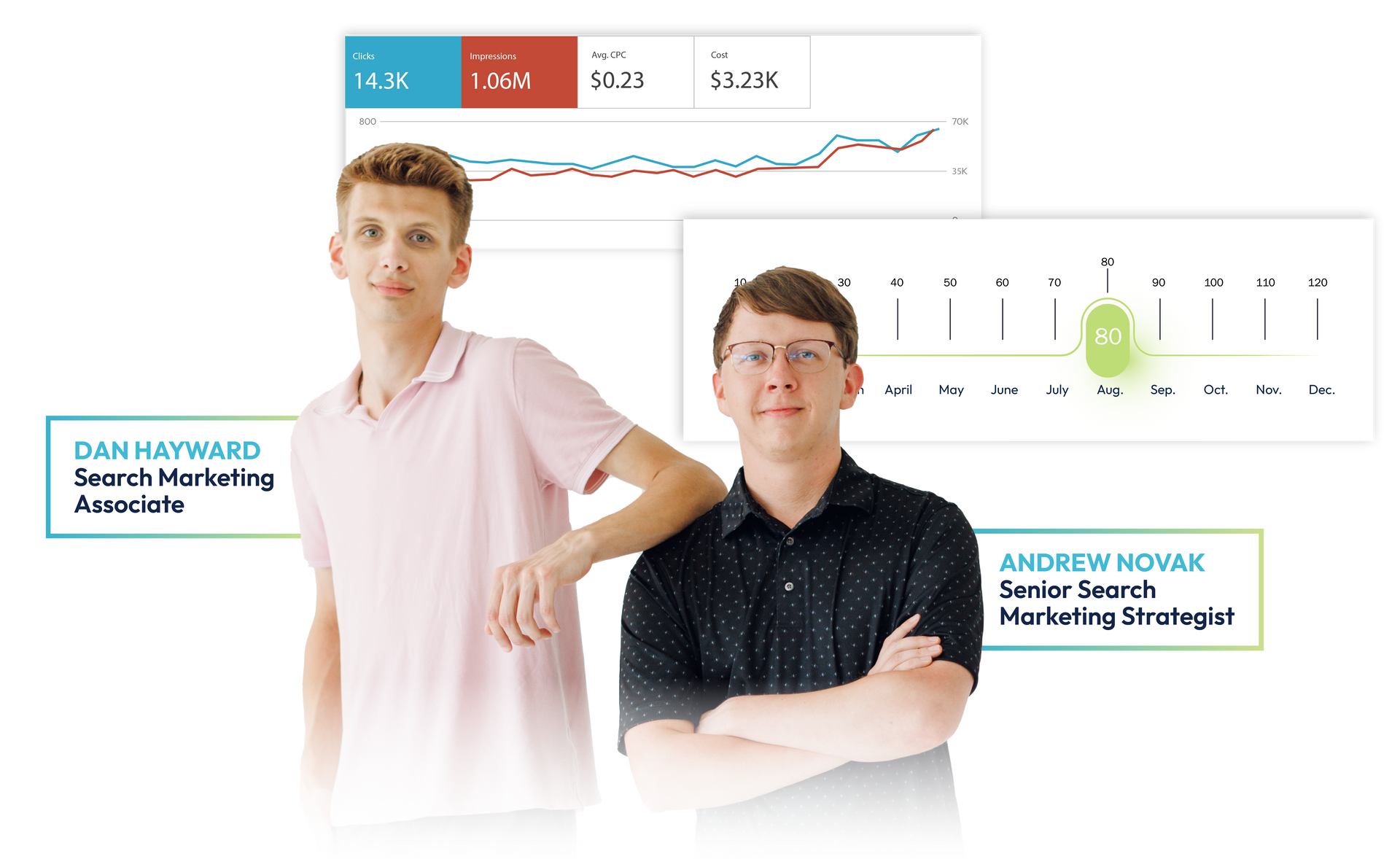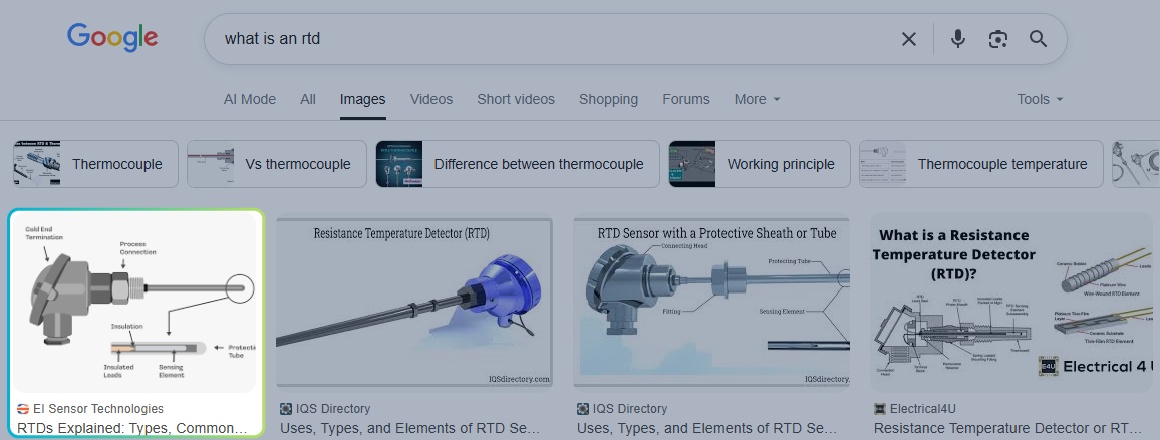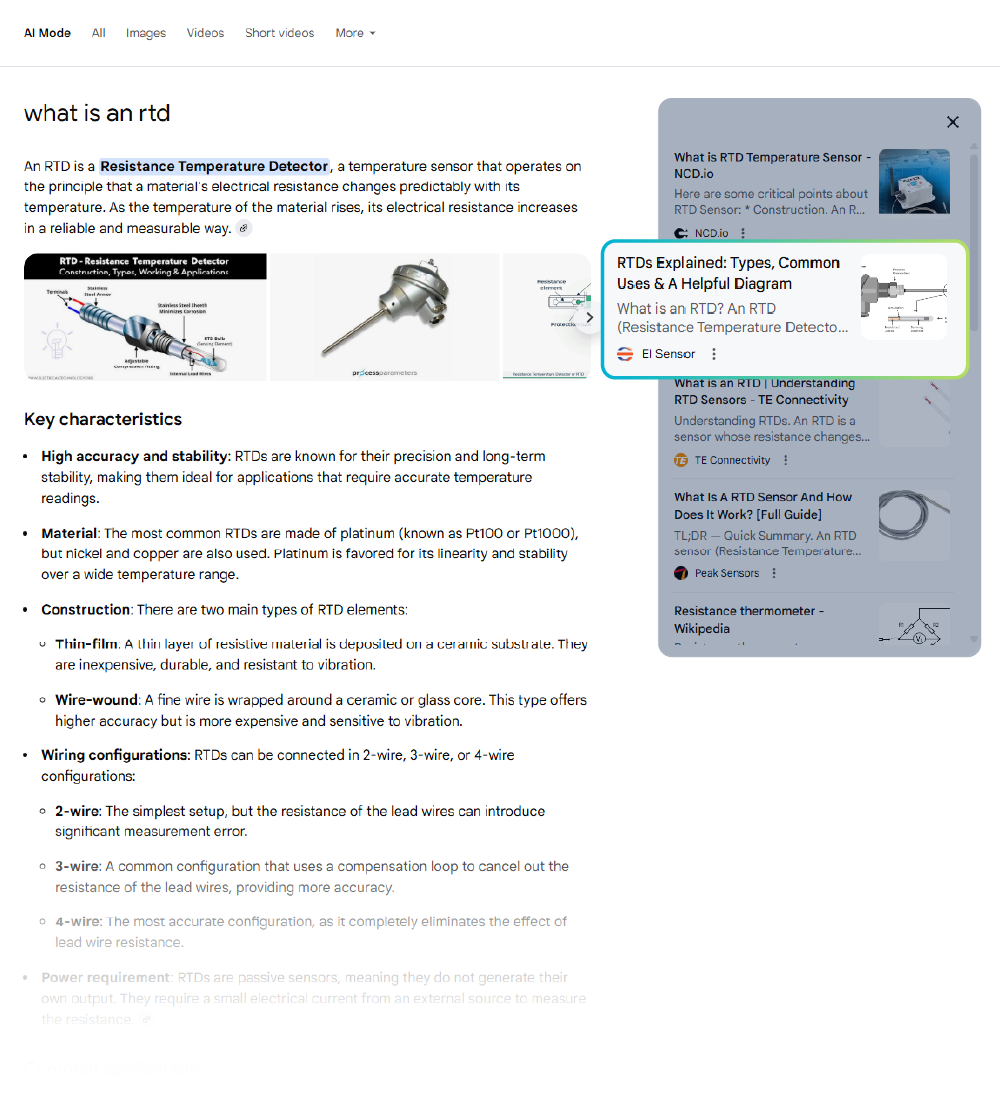How an RTD Infographic Earned a Spot in Google’s AI Overview and Boosted Technical SEO Results
About six months ago, EI Sensor Technologies came to us with a clear goal, they wanted to grow their online presence and get in front of more engineers, product designers, and technical buyers. Their products were solid, their knowledge was deep, but their website wasn’t generating the kind of visibility or engagement they needed.
They were showing up in some places, but not consistently. Core questions like “what is an RTD” weren’t pointing to their site. Their product pages weren’t ranking as well as they should. And they weren’t capturing traffic in key regions they served.
So we put a strategy in place. Regular blogging around key sensor-related topics. Service pages built around location-specific keywords. And a deeper focus on refining their core product and collection pages by tightening the copy, aligning it to search intent, and making sure Google could actually read and rank it properly.
The purpose to the strategy we initiated was about building authority and laying the groundwork to win the long game — and now we’re starting to see the results.
A Strategy Partner That Knows Technical SEO
EI Sensor teamed up with RivalMind because they needed a partner who understood both the language of engineers and the mechanics of search visibility. We’ve worked with technical manufacturers across a range of industries, so we know how to translate expert-level knowledge into content that ranks, builds trust, and drives engagement.
The goal was never just to publish more pages. It was to create a system that consistently pulls the right audience in and shows them the value EI Sensor brings.

Content Designed for AI-Powered Search

One of the early wins in this strategy came from a single question: What is an RTD?
That query had strong search volume, clear informational intent, and high relevance to EI Sensor’s products. So we developed a blog post that answered the question thoroughly, but in plain, helpful language. Alongside that content, we created a custom RTD infographic, something visually clean and technically accurate that would support the explanation and stand out in image results.
From there, we applied our SEO framework:
- Structured content built around real search terms
- On-page optimization for both text and visuals
- Alt text, filenames, and metadata for image search
- Internal linking to relevant product and collection pages
- A layout and structure built to support AI-powered indexing and feature inclusion
It was all designed to make the content easy to find, easy to understand, and easy to trust.
Launch, Monitor, Improve
We launched the blog and infographic as part of the ongoing content rollout, then kept a close eye on performance. We tracked rankings, monitored image placement, and checked whether the blog was being picked up by Google’s evolving AI features.
At the same time, we continued refining other pieces of the strategy by building more educational content, expanding location-based service pages, and improving product-level SEO. Each new piece helped support the bigger picture: making EI Sensor more visible, more credible, and easier to discover across the entire buyer journey.
Why Visibility in AI Overview Matters Now
Google’s AI Overview is changing how users experience search. More and more, users are seeing AI-generated summaries at the top of search results, built from pages that Google sees as authoritative and clear.
That’s where the opportunity, and the risk lies. If your content is optimized for those answers, you can be part of the summary. If not, even good rankings might get overlooked.
Here’s what recent research shows:
- About 26 percent of U.S. searches now include an AI Overview
- Clickthrough to organic listings can drop by 30 percent or more when AI Overviews appear
- Pages that include well-structured content and optimized visuals are more likely to be pulled into those summaries
Getting your content into that space is no longer optional. It’s becoming a competitive necessity.

Visibility, Rankings, and Real SEO Growth
That RTD infographic started showing up in the AI Overview for “what is an RTD,” right alongside the content we wrote. It also began ranking first in Google Image Search. And that visibility has had ripple effects.
Here’s the performance snapshot:
- Blog sessions increased by 133 percent
- Engaged sessions jumped 116 percent
- The Threaded Thermistor Probes collection gained 35 percent more sessions
- The Thermistor Probes collection rose by 30 percent
- The ED35S Glass Encapsulated PTC Thermistors page saw over 1,100 new impressions
- The RTD collection page gained more than 1,100 additional impressions
This wasn’t just a blog post ranking well. It created lift across the site, improving performance for both educational and commercial content. The infographic didn’t just explain, it opened the door to higher visibility, more engagement, and better product awareness.

From Missed Opportunities to Search Leadership
EI Sensor went from being underrepresented in search to being featured directly in one of Google’s newest and most prominent features. EI Sensor is appearing in results and being recognized as a top resource for the topics they care about.
That single win, one blog, one infographic, became a proof point for the larger strategy. And now we’re building on that momentum with more technical content, more visuals, and a continued focus on what works in AI-powered search.
This is what the long game in SEO looks like. Steady, intentional moves that start to stack real wins over time.
What We’re Learning About Visibility in AI Search
This kind of result didn’t happen overnight. It wasn’t driven by luck. It came from a clear strategy, consistent execution, and content that was built to teach well.
Seeing EI Sensor Technologies now showing up in Google’s AI Overview, with their infographic pulled in as a featured visual, confirms what we’ve been seeing across the board. When you combine clarity, visual structure, and search intent, you give Google what it needs to surface your content in new and more dynamic ways.
This was a turning point for them. But it’s also a reminder for all of us: AI is reshaping how people search and how visibility is earned. And if you’re paying attention, there’s real opportunity to be discovered in ways that didn’t even exist six months ago.

Meet the Author
Andrew Novak
Senior Search Manager
Andrew is a senior search marketing strategist who thrives on finding the edge in both SEO and PPC. He loves digging into data, spotting opportunities others miss, and turning smart strategies into real growth. He enjoys the challenge of balancing quick wins with lasting momentum, always looking for ways to push performance further.
Specialties: Consistent results, Client Customer Service, Strategy Guru
Looking for more organic website traffic?
Welcome to RivalMind. Our purpose is to help your business thrive. We are a digital marketing agency that offers SEO, PPC, Web Design, Social Media and Video Solutions as tools to our clients for online business development and growth.
Contact us today to get started!
Blog Contact Form
Connect with Us:




